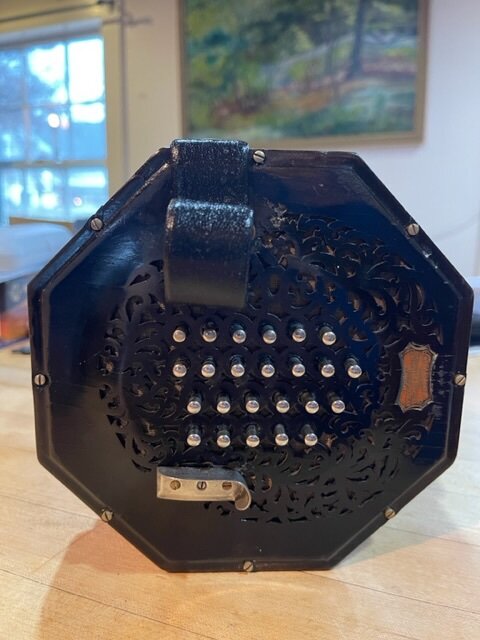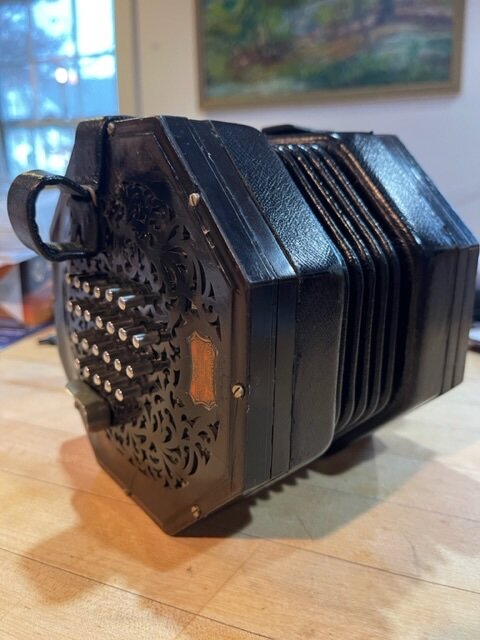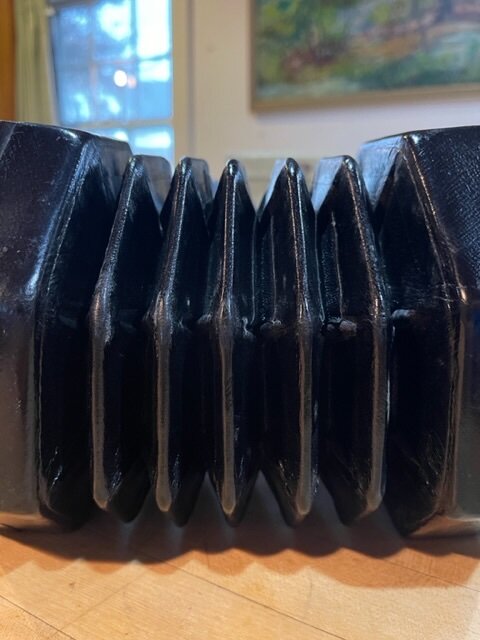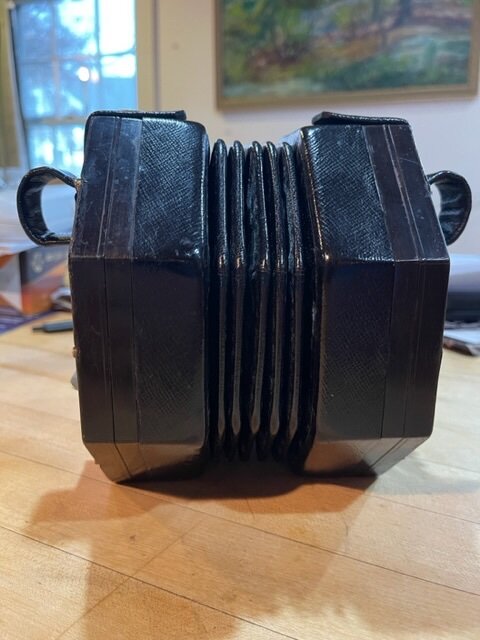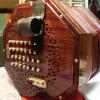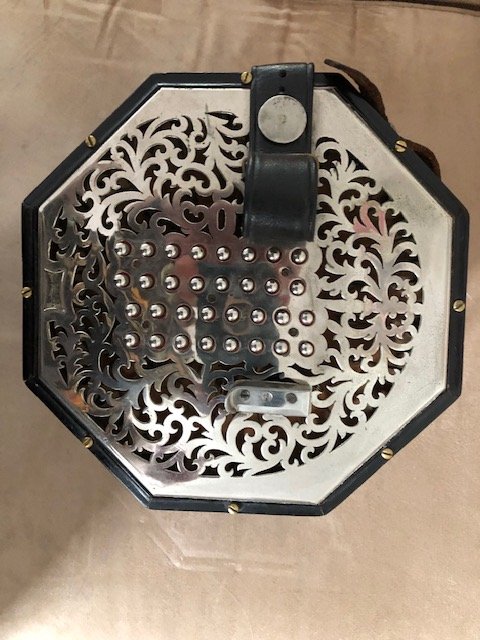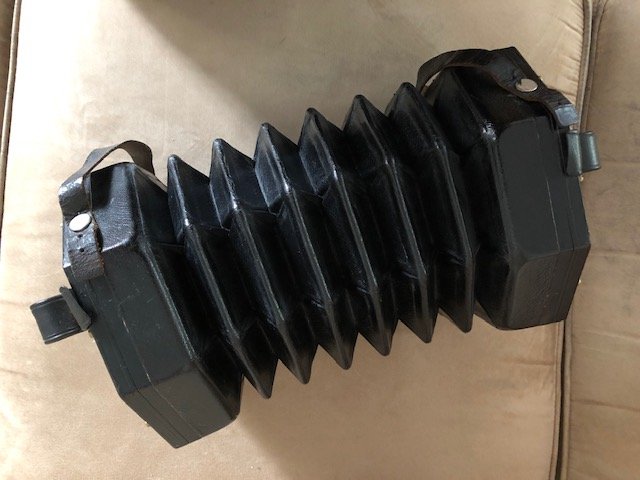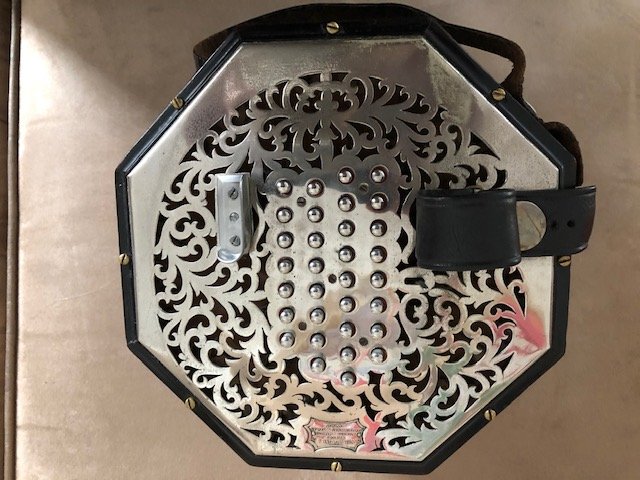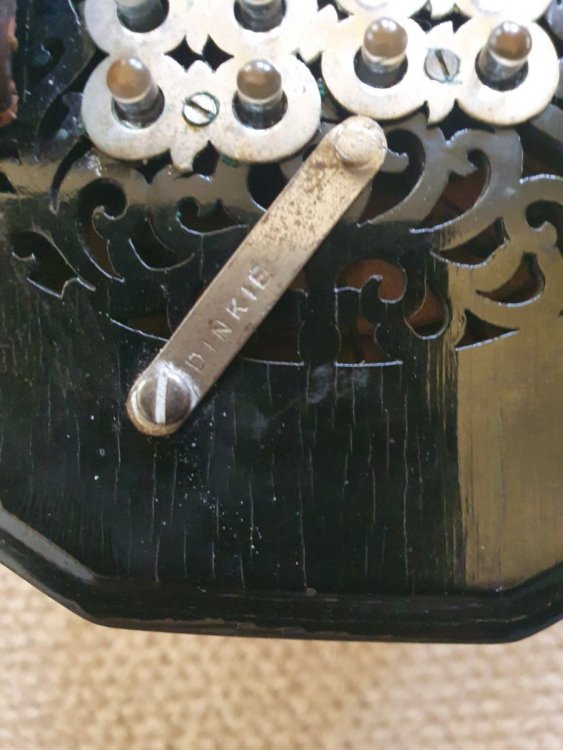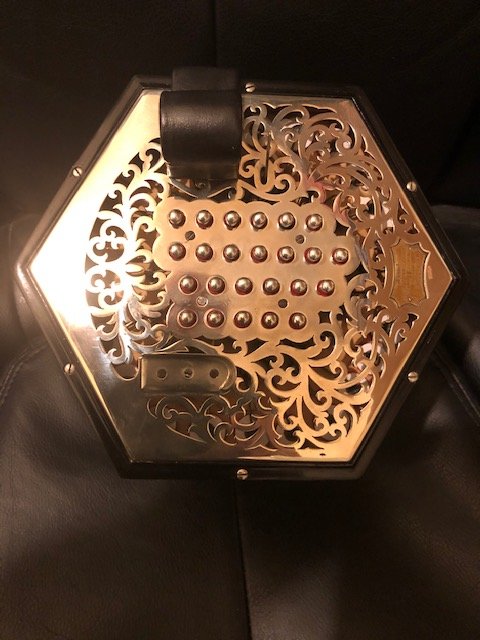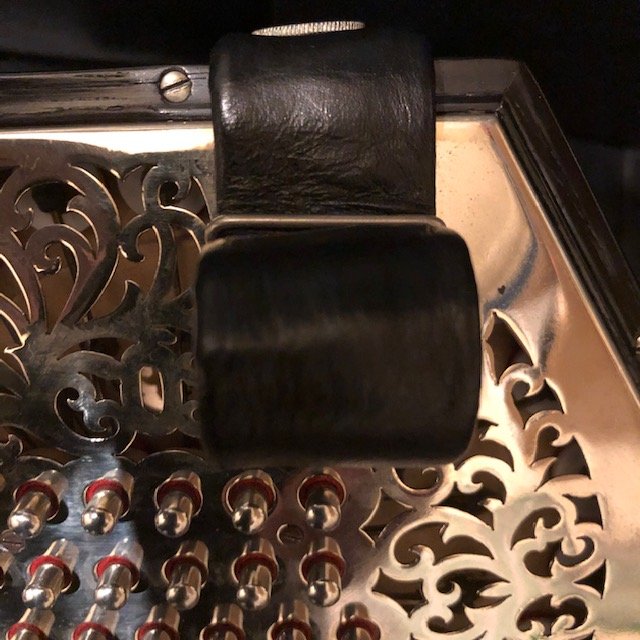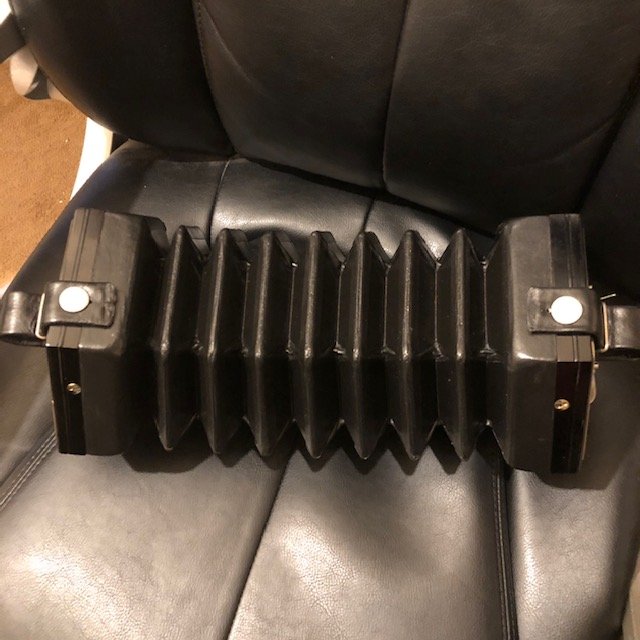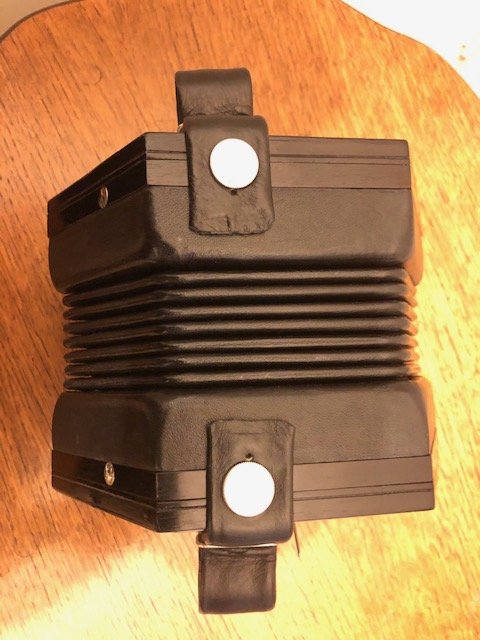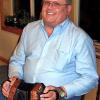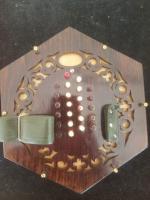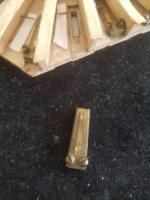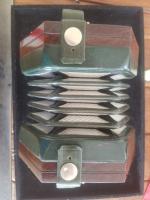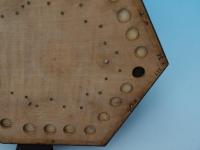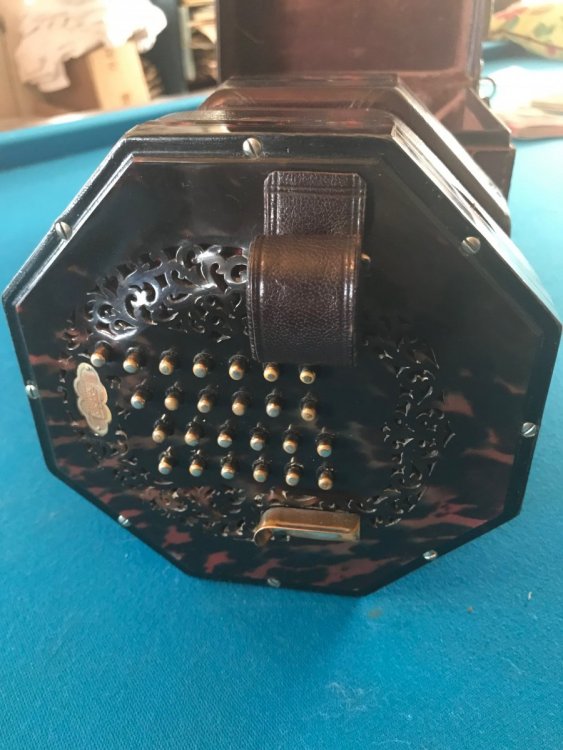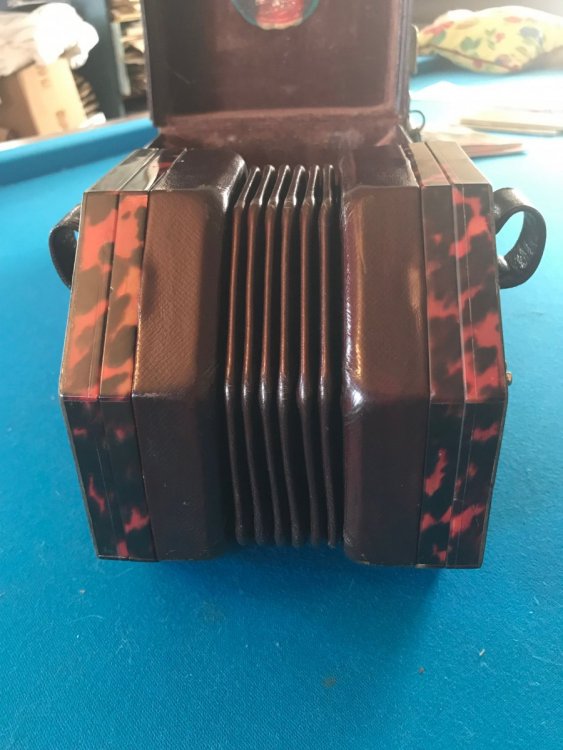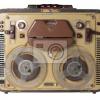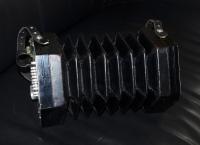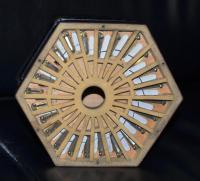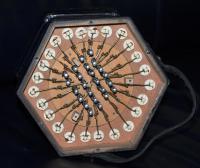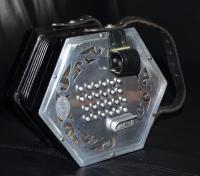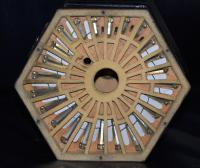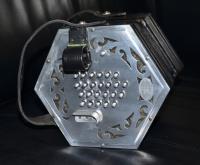Search the Community
Showing results for tags 'english'.
-
Just for fun, and available through www.zazzle.com (search "Rollstonpress"), here are some concertina t-shirts for Wheatstone, Lachenal, and even one for Maccannics that even includes The Professor's visage and signature. While The Wife prefers name-brand stuff with logos, I'd much rather have something I'm interested in that's totally obscure and that no one has any idea what it is. And, if anyone would like to be a human billboard, there's also a Rollston Press shirt with a sampling of some of the book covers. The shirts are high quality print-on-demand, you decide what size and color, and Zazzle often puts things on 20-30% discount. Thanks to Steve Dickinson for permission to include the graphic from an old Wheatstone pricelist. And as they should, a portion of the proceeds will go to CNET. Gary
- 10 replies
-
- 1
-

-
- wheatstone
- lachenal
-
(and 3 more)
Tagged with:
-
I'm just curious about what other English concertina players do when it comes to playing in keys where your fingers could choose one of the two same-sounding notes, like C# or Db, G# or Ab, etc.. I was playing something in the key of C# this morning, a simple tune, and if I was 'correct' and strict about what note to play, I had to consciously be careful to choose a d# (d sharp) when I encountered that note. What my fingers naturally wanted to play was actually the eb (e flat). At least in this case. I know it doesn't really make a difference, as far as how it sounds. And I'm guessing that if I were playing something very classical or complex, I'd probably find it more normal to play 'correctly.' But, with a simple tune, I find that my fingers just want to balance the distribution of buttons between my left and my right hand. Any thoughts on this?
-
I recently tried to play the "organ" line for Telstar on the English Concertina. It starts with four major chords F# G G# A they are all easy enough to play individually, but moving between them is very tricky because there is (obviously) no note or backup position in common between successive chords, and i often get lost whilst moving up or down a semitone. I'm hoping to have 4 notes playing for each chord with the tonic at the top and bottom. Is there any hope at all for a smooth succession of chords? This got me started on trying to do what I probably should have done years ago, which is to practice chord scales. Most of the chords are not complicated but some are fiendish as part of a semitone scale including C# and G# (even though I have a choice of Ab or G#). Has anyone got any hints and tips on how not to get lost going up and down a semitone-scale ? Before I develop some very bad habits ? I havnt even started on minor chords yet.... Thank you Gail
-
a musical sign of life - a spontaneous live recording (first take) after having set up a decent audio recorder for my smartphone https://soundcloud.com/blue-eyed-sailor/kolomtanz-sailors-hornpipe as always, any comments are appreciated. edited to add: playing my model 24 Wheatstone EC here
-
Thanks to help from people in this forum, I was able to locate and make contact with the owner of Concertine Italia. Last Thursday, I visited the factory and spent a couple of hours talking with the two women who make pretty much every part of their instruments, with the exception of the reeds and reed blocks. A lot of people helped me along the way. I'm especially thankful to my new friend Enrico, who thought a visit to a concertina factory would be a good adventure and offered to drive me there, and to serve as translator. I can speak a little Italian but quickly got lost in the specifics. The owner, Mrs. Simona, is an awesome person as is her only full time employee Rosalia. Together they make a range of instruments including an adorable tiny 18 button chromatic, and the Italian organetto. They say that their most popular model is the Hayden. I am so grateful to have had this opportunity. I think you will like these awesome makers as much as I do. You can find the video at
-
If you don't ask, you won't receive... Wanted to purchase: Wheatstone Aeola 56 key, Tenor Treble English concertina, ebony ended (EE). TT, model 19, C to C, 31xxx serial number (1926 to 1928), clean inside, well taken care of, original leather case. Please message me and let me know what you have or message me (PM me) if you see or hear of one for sale. I will be more than happy to make a significant donation to concertina.net if my dream TT is found through this site. .
- 4 replies
-
- tenor treble
- tenor-treble
- (and 9 more)
-
Beautiful 48 key English Wheatstone. I’ve owned it for almost 40 years but I don’t play this one anymore. Totally refurbished at The Button Box a few years ago. Asking $4500
-
- wheatstone
- english
-
(and 2 more)
Tagged with:
-
https://schoolofmusicaltraditions.square.site/product/introduction-to-the-concertina-with-randy-stein-and-jim-besser/130
-
I am looking to purchase a 48 button Stagi English Baritone Concertina. Any help is greatly appreciated!
-
I am selling a Hohner C48 2 x 24 button english concertina - rarely played. As I hardly find the time to play this english concertina, it searches a good house where it will be played and not just be stored in its gig bag. Details: Wooden ends - A suitable beginners instrument It is in concert pitch, it has 48 white keys - playing smoothly and sounding okay on push and pull. It has an air release key. The bellows is air tight. The condition is very good - like it just left the factory, the Hohner gig bag is included Shop price is 400 UK pounds. Asking 200 pounds. PM me if you want pictures or if you're interested to buy Marien
- 2 replies
-
- english
- concertina
- (and 5 more)
-
I am a beginner looking for a concertina not over $370. I know it's a far stretch, but I don't have much money to spend. I would like it to be English/Duet but it doesn't really matter which one it is out of these. Thanks so much!
-
Composed by James F. Hanley in 1917. Jim Besser - Baritone Anglo Concertina Randy Stein - English Concertina *originally performed in the Eastern North America Online Concertina Concert for World Concertina Day) https://youtu.be/hCSUlaf4DR4
- 3 replies
-
- 2
-

-
- 2many buttons
- anglo
-
(and 2 more)
Tagged with:
-
Hi, We've got a a 48 button Lachenal brass-reeded English concertina with mahogany ends that we'd like to sell. These, of course, are not the world's greatest concertinas but they can get a person going. We had it fettled a bit a few years back by Colin Dipper as we wanted to lend it to a couple of people (like Anne's composition professor at university ). All notes play and are in tune (concert pitch) Four or five are a little bit buzzy but nothing excessive and should be readily sortable. As you'd expect with a brass reeded instrument it's not the lightest box to play by any means but it does have an undeniable sweetness of tone. We don't have a case for it, sorry, but it will be very well packed for posting. We'd like to get better than £300 plus postage for it if we can. Here are some photos: Cheers, Chris & Anne
- 8 replies
-
- brass-reeds
- english
-
(and 1 more)
Tagged with:
-
A beautiful 64-button extended tenor treble for sale. In very nice condition, bellows are original and very good. This one was made in January 1919, from the golden era. 6-fold bellows The instrument is tight and plays beautifully. Typically selling for 3700+ at the dealers. I am asking for 2900 pounds equivalent (C$5000). The instrument is in Toronto, Canada but will ship anywhere (shipping and insurance extra). Message me if interested.
- 5 replies
-
- wheatstone
- aeola
-
(and 1 more)
Tagged with:
-
Has anyone seen a "Dinkie" pictured on an Edeophone, it appears to be specially made to sit on top of the G & F buttons, the only thing I can think of is that it provides a drone. This is on a 56 button made about 1914
-
Very reluctant sale! Supreme example of a Wheatstone 22 series fully restored to new condition by Roy Whiteley (hardly played since). Brand new 7 fold leather bellows, raised nickel silver plated ends and buttons. Beautiful, strident, yet sweet tone…bags of ‘throw’. Very powerful instrument – excellent for all kinds of dance music, ensembles, song accompaniment etc; Comes with hard flight case - £4000.00. Please PM me if interested or leave questions as a comment to this post. Collect only or outdoor Covid-19 safe rendezvous.
- 1 reply
-
- wheatstone
- series 22
-
(and 1 more)
Tagged with:
-
Second hand Jackie, English concertina, suitable for beginners. 30 buttons. In excellent condition and includes tutor book and soft case. £290.
-
Hello, I’m looking for advice on what to purchase. I have a cheap 20 key anglo concertina, which I play from time to time, but I’ve played string instruments for a long time. For some time now, I’ve wanted a concertina with chromatics and to accompany singing. What are some recommendations for a first English concertina? I looked online at a 30 key baritone English concertina (“Jack”) from Concertina Connection. Would this be appropriate, given my situation? John
-
Collected October 28 of 2013 I saw Bruce Thomson's video today and thought it might be of interest to the group and so decided to explore other recent YouTube additions to flesh out this posting. These are listed in the order found: Bruce Thomson - Knee straps experiment http://youtube.com/watch?v=a26xSS8VrP8 Katyusha - balalaika and concertina http://youtube.com/watch?v=8vSCBeibduI Comparison of Stagi and Chinese concertinas http://youtube.com/watch?v=nPDf4vWTRPU A New Player http://youtube.com/watch?v=RfYQ6S_3F7M http://youtube.com/watch?v=c-haW0l3jRY Oria Quirke with Draíocht Nua http://youtube.com/watch?v=Lw9pWSa3kow Yvonne Bolton and Alan Jordan at Custy's http://youtube.com/watch?v=eQF1PxGLdu8 After watching the Custy's video of Yvonne and Alan a second time I was motivated to further explore their YouTube offerings. I especially liked this one (placed on YouTube in September of this year) and decided to edit it into my posting here today. While clearly promotional for their CD, I think it's very well done: http://youtube.com/watch?v=cwjJ5C348no
- 2 replies
-
- concertina
- english
-
(and 1 more)
Tagged with:
-
Early English Concertina. Unnamed. Buttons: 48 Stained red/black and marked with note values on whites. Bellows: four-fold. Dark green with starburst papers. Bellows are sound. Serial number: 112 Reeds: brass in brass shoes with squared ends, stamped with note values. Valves cut square as per original. Condition: excellent internal and external condition. Fully restored on a historical basis by Andrew Norman in 2016. Plays at modern concert pitch. Sweet tone, not loud. Case: Victorian scientific instrument case with sliding top and handle. Name card of owner pasted in the top: Daniel Whitelaw, Glasgow. The name of the maker cannot be ascertained; but Andrew Norman thought is resembled work by William Dove. 1,700 pounds sterling. Estimated shipping to Europe, USA or Australia: 80 pounds.
-
I was looking at this video of Simon Thoumire: When he plays, his fingers seem to be moving horizontally along the 'columns' of buttons. Is this a special technique? Do you have to move the thumb straps for it?
-
Does anybody have experience with "standard bellows" vs. "wakker bellows" on an English Concertina? I know about the difference in theory but have no chance to try it out (in Germany it's hard to find concertinas). I got a special offer for an unused Rose with standard bellows. It is $800 less than what I would need to pay here for a Rose with wakker bellows. My budget is limited, so the reduced price is very welcome. But if the wakker bellows make such a tremendous difference I could also safe a bit longer... Any experience or recommendations? Thanks Jürgen
- 1 reply
-
- bellows
- concertina connection
-
(and 2 more)
Tagged with:
-
Beautiful tortoise shell 51 key Wheatstone aeola for sale. Just overhauled by the Button Box. Comes with original case. Smooth action, in tune, concert pitch, 6 fold bellows very tight. Serial Number 33234. Many inside photos upon request. Located north of Boston. david at davidcoffin dot com Will donate an appropriate amount to concertina.net.
- 19 replies
-
- wheatstone
- aeola
-
(and 3 more)
Tagged with:
-
I am selling my Treble Crabb English concertina, serial 18081, as i don't play it so often anymore. I bought it new around 1966 from H. Crabb himself. in those days he offered aluminum sides instead of the fancy cutted chrome ones at a slightly lower price, nevertheless the sound is still fabulous and tuning is fine. All reeds, leathers etc. are too, with no rust on reeds or mold and the instrument is not leaky, just as Mr Crabb told me then it would be for at least 20 years to come if i kept it away from moist, cleaned the bellow folds at times, and warm it up coming in from the cold especially, to avoid condense settling on the reeds etc. before playing. In the past i took it to gigs and used in theater circumstances, so it shows some signs of wear, but no damages apart from light scratches etc. I'm looking for a fair price offer, and then maybe a deal. PS the original case is present, in good condition, but has stickers on it. Location The Hague, Netherlands.
- 12 replies
-
I posted the text below elsewhere. However, I thought that it might attract further discussion by being posted on its own. It concerns the question of whether to finger consecutive notes on C# and F# on the English concertina using fingers 1 & 2 or 2 & 3 (two-finger rolls by Simon Thoumire's terminology ?). In a jig on the English moving across to the lower F# on the right, for example, the two-finger roll technique to play a triplet (three consecutive notes on the same button) implies using fingers 1 & 2 all the time, yet this requires one to travel quite some way across the finger board. I've given a sample. It's a decoration, of course, but one that I wish to conquer. When attempting this with fingers 2 & 3 it feels much weaker and slower. There are, in fact, four F# notes to negotiate in this, so there is the problem of how to ensure that one's fingers fall on the buttons in the correct order. Looking forward to suggestions as to how to overcome this difficulty.











